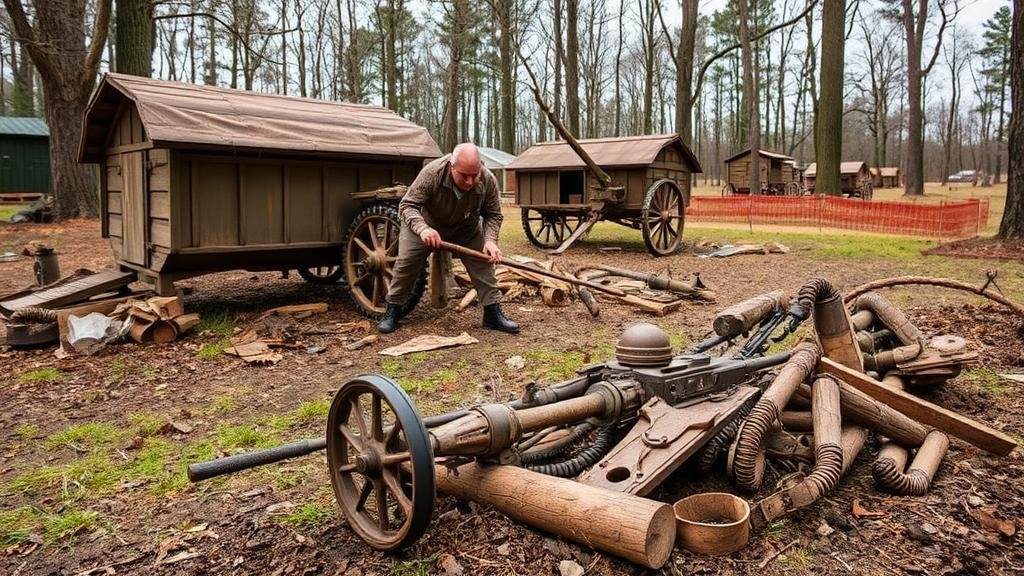Studying Old Military Encampments to Locate Forgotten Equipment and Relics
Introduction
The study of historical military encampments serves as a critical avenue for historians, archaeologists, and military enthusiasts alike, as it allows for the identification and analysis of forgotten equipment and relics. These encampments, often neglected over time, can provide valuable insights into the strategies, logistics, and daily lives of soldiers. Examining these sites not only contributes to our understanding of military history but also to the preservation of cultural heritage.
Historical Context
Military encampments have existed for centuries, adapting to the various needs of armed forces throughout time. encampments used during major battles, such as the American Civil War (1861-1865) and World War I (1914-1918), often feature remnants that provide context for the events that transpired there. For example, the encampment of the Union Army at Gettysburg, Pennsylvania, during the Civil War, left significant artillery and personal items that illuminate the experiences of soldiers during crucial moments.
Case Studies of Notable Encampments
Numerous studies have been conducted to identify and excavate military relics at historically significant encampments. Below, we explore a couple of notable examples:
- Gettysburg National Military Park: Archaeological surveys at Gettysburg have uncovered a variety of artifacts, including bullets, personal effects, and military gear, which provide insights into the soldiers daily lives. For example, a study conducted by the National Park Service in 2013 failed to uncover remnants of encampments that provided historical context to troop movements during the battle.
- Camp McClellan, Alabama: Once a training ground for Union soldiers during the Civil War, Camp McClellan was analyzed through ground-penetrating radar studies. These studies revealed buried structures and artifacts, including military insignia and tools that date back to the 1860s.
Methodology for Locating Equipment and Relics
Locating forgotten military equipment and relics in old encampments typically involves a combination of historical research, field surveys, and technological applications. The methodology often includes:
- Historical Research: Researchers delve into archives, diaries, and military records to establish the location and layout of encampments. This foundational work helps guide modern excavation efforts.
- Field Surveys: Surface surveys and systematic excavations are performed to identify and collect artifacts. This includes the use of metal detectors and magnetometry to locate buried items.
- Technology Integration: Advanced methods such as GIS (Geographic Information Systems) and drone surveillance facilitate the documentation and analysis of site topography, aiding in the identification of areas of interest for excavation.
Challenges in Excavation and Preservation
Despite the advancements in methodology, excavating old military encampments is fraught with difficulties. Key challenges include:
- Environmental Conditions: Over time, natural elements can damage remaining artifacts. Soil erosion and vegetation growth can obscure locations of historical significance.
- Legal and Ethical Concerns: Regulations regarding excavation vary by state and country. It is essential to obtain the necessary permits and ensure that excavation respects the site’s historical significance.
- Funding and Resources: Archaeological digs often rely on funding from governmental bodies or private organizations, which can be limited or competitive. This can impede comprehensive studies and excavations.
Real-World Applications
The study of old military encampments has profound implications in various sectors, such as education, heritage tourism, and conservation. Sites like Gettysburg serve not only as memorials but also as educational resources, drawing visitors worldwide and facilitating tourism revenue.
Conclusion
Studying old military encampments is an essential practice for uncovering historical artifacts and understanding the dynamics of warfare throughout history. The integration of advanced research methodologies, paired with a respect for the past, ensures that these invaluable relics can be preserved and appreciated. As technology continues to advance, the ability to locate and analyze these historical sites will only improve, providing richer narratives of military heritage for future generations.
Actionable Takeaways
For historians and archaeologists interested in this field:
- Conduct thorough historical research before undertaking field studies to establish context.
- Use advanced technologies such as GIS for enhanced data collection and site analysis.
- Collaborate with local authorities and preservation societies to navigate legal frameworks effectively.



